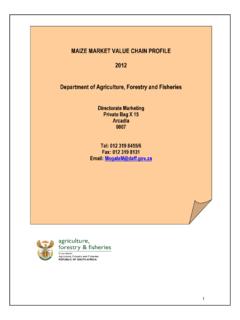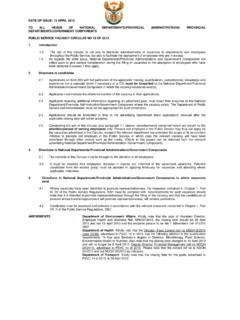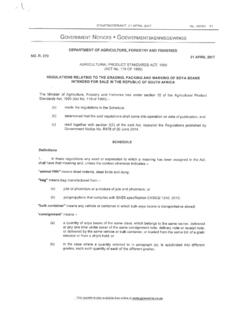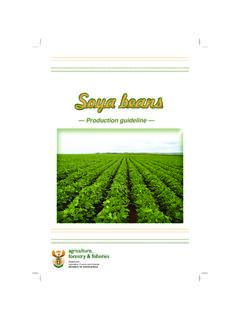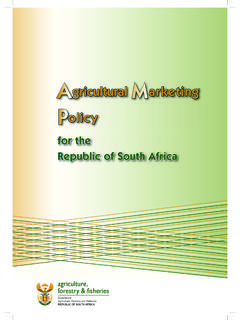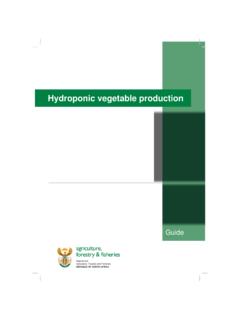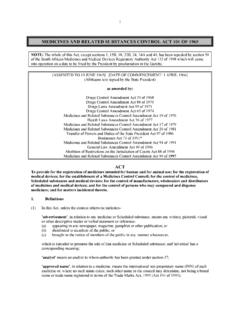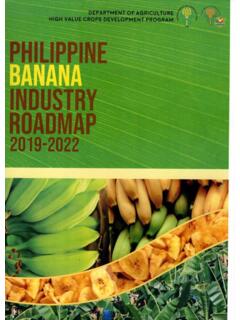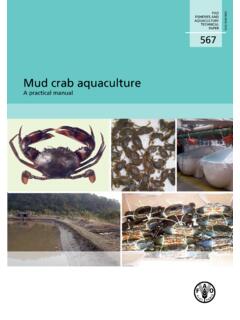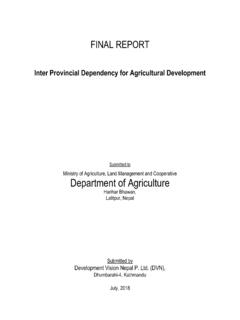Transcription of Hydroponic vegetable production guide
1 agriculture ,forestry & fisheriesDepartment: agriculture , Forestry and FisheriesREPUBLIC OF SOUTH AFRICAG uideHydroponic vegetable productionHydroponic vegetable productionDirectorate: Plant ProductionDEPARTMENT OF agriculture , FORESTRY AND FISHERIES2011 Printed and published by department of agriculture , Forestry and FisheriesDesign and layout by Communication Services Private Bag X144, Pretoria 0001 Basics of hydroponics 3 Differences between Hydroponic vegetable production and soil production 4 The different types of Hydroponic systems available 5 Advantages of hydroponics 6 Disadvantages of hydroponics 6 Harvesting 7 Pests and diseases 7 Tips to prevent spread of diseases 7 Uses of pesticides 7 Legal aspects 8 Acknowledgements 8 Contents1 What is hydroponics?
2 Hydroponics is a technology for growing plants in nutrient solutions (water containing fertilizers) with or without the use of an artifi cial medium (sand, gravel, vermiculite, rockwool, perlite, peatmoss. coir, or sawdust) to provide mechanical seen in the picture, irrigation pipes carrying nutrient solutions (water containing fertilizers). Also notice the plastic containers containing artifi cial medium to provide mechanical supportLiquid Hydroponic systems have no other supporting medium for the plant roots: ag-gregate systems have a solid medium of support. Hydroponic systems are further categorized as open ( once the nutrient solution is delivered to the plant roots, it is not reused) or closed ( surplus solution is recovered, replenished, and recycled). Hydroponic growing (as opposed to soil growing) allows you to control the nutrient levels for your plants directly.
3 Because of the higher control over nutrients, hydroponi-cally grown plants generally have a much higher yield than similar plants grown in growingA plant gets its food source by turning Co2, light and water (or hydrogen) into carbo-hydrates through a process called photosynthesis. With hydroponics growing, plants are grown without soil so they must get their nutrients from the nutrient solutions added to water. The absence of soil in growing means that hydroponics systems must have some way of supporting the plants while still allowing the bare root system maximum exposure to the nutrient solution. Often a growing medium is used for support and to aid in moisture and nutrient retention in hydroponics growing. Because they lack media to store water and nutrients, water culture systems need a continuous fl ow of nutrients to prevent drying out the plant roots.
4 2 Plants need an energy source in order to grow. With hydroponics growing this energy may come from natural light, which has the full spectrum of color or through the use of different types of artifi cial lighting (grow lights), which can be selected for specifi c plant varieties and optimum plant growth characteristics. What do you need to start Hydroponic production ?Garden production unitCommercial production unit Source of clean water The right location Specially formulated fertilizer Time to attend to the system daily A little knowledge of plants or gardening A commercial or home made unit Water is the most important considera-tion, that is in terms of quality, quantity and reliability. Market. Know what, where and when to market your crop. Hydroponics is labour intensive. During peak season, labour must be available for 7 days a week.
5 Management skills: production , labour, marketing and infra-structure. Expertise in crop production , fertilisation and irrigation, pests and disease man-agement. Location: Infra-structure, labour, market, etc. Financing: The amount needed depends on the size, type of greenhouse, labour cost and your market. Dedication: labour and management in general. 3 Garden production unit (above picture) vs commercial production unit (below) With garden production unit, source of energy derived from natural light whereas with commercial production unit, source of energy derived from artifi cial lighting (grow lights).Basics of hydroponicsTo be able to produce vegetables successfully year after year, one needs to be fa-miliar with the basics of hydroponics in term of the plant, growing medium, water and crops can be grown in hydroponics?
6 Basically all high value crops can be grown. Popular in South Africa are tomatoes, cucumbers and peppers in drain to waste systems and lettuce and herbs in gravel fl ow cay you buy seeds?Seeds are available in small or large packages. Small packets are sold at nurseries, co-ops and retail stores and are suitable for garden and small-scale Hydroponic units. Large packets, suitable for commercial scale production are available from seed care of plantsDifferent crops are planted at different spacing. Small-growing plants can be planted close to each other. Large-growing plants need more space to grow and must be spaced further apart. 4 Water fl ow must be checked every day and adjusted when necessary. If plants turn yellow, it is normally a symptom of nutrient defi ciency, too little light or a disease.
7 Inspect the leaves every day for disease symptoms and insects. Act immediately if a problem occurs. Tall plants need to be trained and pruned to make optimal use of the expensive greenhouse between Hydroponic vegetable production and soil productionHydroponicField production No soil is required. Good topsoil is required. Good soil = good drainage, compost, dis-ease-free. Plants are irrigated automatically. No water stress. Plants need to be irrigated to minimise wa-ter stress Plants are irrigated automatically. No water stress. Plants need to be irrigated to minimise wa-ter stress Nutrients are available at all times Only soluble fertilizers are used. Hydroponic fertilizer formulations con-tain a balanced nutrient content Nutrients must be added to soil. Unless a laboratory analysis is done, too much or too little nutrients can be added.
8 Soil borne diseases can be eliminated Soil borne diseases can build up in the soil. Hydroponic production is not organic because artifi cial nutrients are always used and plants are usually not grown in soil. It is possible to produce organic vegetables in soil because one can use organic fertiliz-ers such as compost and systems Using hydroponics systems, mineral nutrients are dissolved in water and feed directly to a plant s root system allowing the plants to focus their energy into growing mostly upward, promoting quicker growth, faster harvests and higher yields. Hydroponics systems are used year-round both indoors and outdoors for growing herbs, foliage and food items. Hydroponics setup do not use soil but instead, use an inert growing medium to anchor a plant s different types of hydroponics systems available include nutrient fi lm, drip watering, aeroponics, Ebb and fl ow and passive fi lmHydroponics gardening utilizing an oxygen rich nutrient solution, is an ideal system for a wide range of crops including lettuce, strawberries, herbs, fl owers, tomatoes, peppers, eggplant, squash and wateringPopular with small commercial hydroponics growing operations, hobbyists and schools this system is designed to grow tomatoes, cucumbers, peppers, herbs and fl ower for starting large crops of seedlings, transplants and cuttings or growing plants or crops to full maturity.
9 This system sprays the roots with nutrient-rich and fl owPopular for rooting cuttings, germinating seedlings and vegetating young plants which are fed automatically with a simple fl ood and drain watering systemsGreat for home or offi ce this system can grow any type of vegetative, fl owering or fruiting plant. The plant determines when it needs water and nutrients. Relatively simple to operate and very easy to maintain, hydroponics systems provide the right conditions allowing plants to grow between two and four times faster than those in of hydroponics No soil is needed The water stays in the system and can be reused- thus, lower water costs It is possible to control the nutrition levels in their entirety- thus, lower nutrition costs No nutrition pollution is released into the environment because of the controlled system Stable and high yields Pests and diseases are easier to get rid of than in soil because of the container s mobilityDisadvantages of hydroponics The Hydroponic conditions (presence of fertilizer and high humidity) create an en-vironment that stimulates salmonella growth.
10 Another disadvantage is pathogens attacks including damp-off due to Verticillium wilt caused by the high moisture levels associated with hydroponics and overwa-tering of soil based plants. Also, many Hydroponic plants require different fertilizers and containment general vegetable crops are perishable and their shelf life and quality depend on number of actions. Such actions include: Pick at the right stage without damage to the plant. Pick early in the morning or when it is cool. Keep picked vegetables out of the sun. Handle carefully. Store them at the right temperature (depends on crop). Use the right packaging (depends on crop and market). Transport with and diseases The optimal growing conditions for plant growth also provide favourable conditions for the development and spread of diseases and pests.

